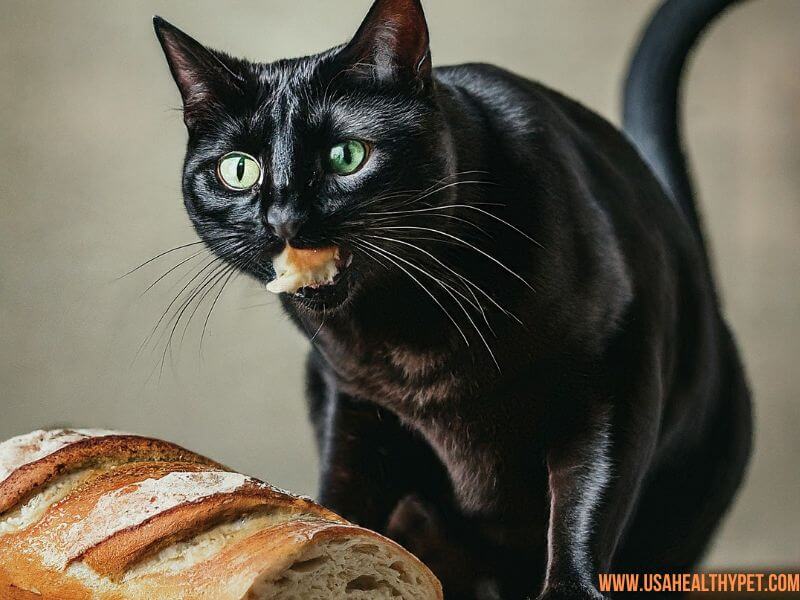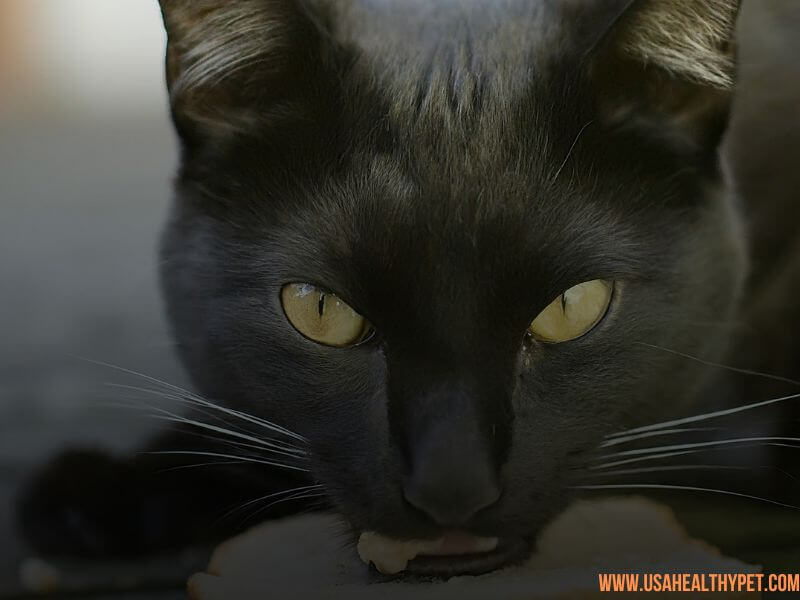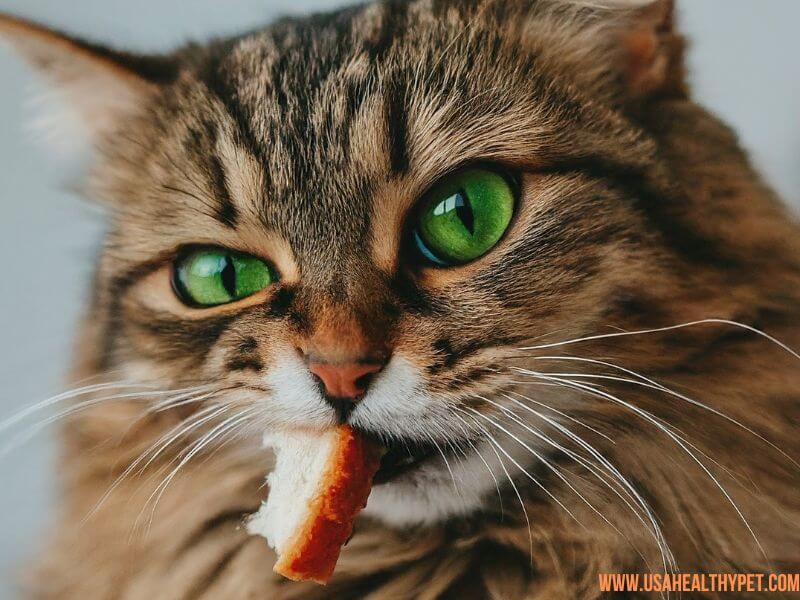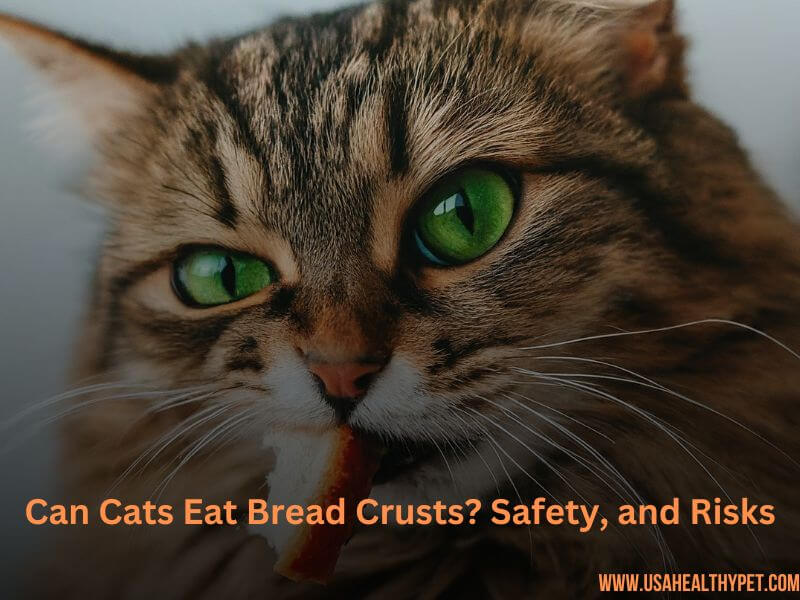- Can Cats Eat Bread Crusts?
- Is Bread Nutritionally Beneficial for Cats?
- Ingredients in Bread Crusts That Could Be Harmful
- Potential Health Risks of Feeding Bread Crusts to Cats
- What to Do If Your Cat Eats Bread Crusts
- How to Keep Your Cat Away from Bread Crusts
- When Should You Consult a Vet?
- Are There Any Bread Products Safe for Cats?
- Conclusion
- FAQs
Can Cats Eat Bread Crusts?
Yes—cats can eat bread crusts, but that doesn’t mean they should eat it regularly. While a small nibble of bread crust here and there is unlikely to harm your cat, bread crusts offer no nutritional benefit to them.
Bread, especially the crusts, simply doesn’t fit into their dietary needs.
Is Bread Nutritionally Beneficial for Cats?
In short, no. Bread, including the crusts, lacks the essential nutrients that cats need. While bread can provide energy through carbohydrates, cats primarily get it from protein and fat.
Feeding your cat bread crusts can fill them up with empty calories, leaving less room for the nutrient-dense foods they actually need.
Ingredients in Bread Crusts That Could Be Harmful
While plain bread crusts might seem harmless, certain ingredients in bread can pose risks to your cat’s health.
Harmful Ingredients in Commercial Bread
Commercially produced bread often contains additives and preservatives unsuitable for cats.
According to the Pet Poison Helpline, ingredients commonly found in bread, such as garlic, onions, and certain herbs, can be toxic to cats.
Even small amounts of these ingredients can cause serious health problems, including damage to red blood cells, which can lead to anemia. It’s important to always check the ingredients of any human food before sharing it with your cat.

The Issue with Yeast and Dough
If your cat gets into raw dough, that’s a whole other problem. Yeast in raw dough can continue to rise in your cat’s stomach, leading to bloating and discomfort.
In severe cases, it can cause a life-threatening condition called gastric dilatation-volvulus (GDV).
Potential Health Risks of Feeding Bread Crusts to Cats
Feeding bread crusts to your cat regularly can lead to several health issues:
Digestive Issues
Bread is not easily digestible for cats, especially in large quantities. It can cause gastrointestinal upset, leading to vomiting, diarrhea, or constipation.
Weight Gain
Since bread is high in carbohydrates and low in nutrients, it can contribute to weight gain. Obesity in cats can lead to a myriad of other health problems, including diabetes, arthritis, and heart disease.
Nutritional Imbalance
Bread can fill your cat up, leaving them less interested in their regular, nutritionally balanced food. This can result in a lack of essential nutrients, affecting their overall health.
A study published in the Journal of Animal Science highlights that cats require a diet high in animal-based proteins and fats to meet their nutritional needs.
The study emphasizes that while cats can tolerate small amounts of carbohydrates, these should not be a significant part of their diet.
Bread and other carbohydrate-rich foods can lead to nutritional imbalances if consumed regularly, which is why it’s best to stick to meat-based treats for cats.
How Much Bread is Too Much for Cats?
A small piece of bread crust every once in a while is unlikely to cause harm.
However, bread should not be a regular part of your cat’s diet. Ideally, bread should only be given as an occasional treat, and in very small amounts.

What to Do If Your Cat Eats Bread Crusts
If your cat manages to sneak a piece of bread crust, there’s usually no need to panic. Monitor them for any signs of discomfort, such as vomiting, diarrhea, or lethargy.
If your cat ate a large amount of bread or you suspect they ingested harmful ingredients, contact your vet immediately.
Signs of Bread Toxicity in Cats
Certain ingredients in bread can be toxic to cats. Watch out for the following symptoms:
- Vomiting or diarrhea
- Excessive drooling
- Lethargy or weakness
- Loss of appetite
- Rapid breathing or difficulty breathing
If you notice any of these signs after your cat eats bread, seek veterinary attention right away.
Healthier Alternatives to Bread Crusts for Cats
Instead of bread crusts, try offering your cat these healthier treats:
- Cooked, unseasoned chicken or turkey – A protein-packed snack that’s sure to please.
- Small pieces of plain, cooked fish – Another great source of protein and omega-3 fatty acids.
- Commercially available cat treats – Formulated specifically to meet your cat’s dietary needs.
How to Keep Your Cat Away from Bread Crusts
To prevent your cat from snacking on bread crusts, make sure to:
- Store bread in a sealed container or bread box – Out of reach from curious paws.
- Dispose of bread crusts promptly – Don’t leave them sitting on the counter.
- Train your cat – Use positive reinforcement to teach them not to beg for food from the table.
When Should You Consult a Vet?
If your cat has consumed a significant amount of bread or shows any signs of distress, it’s best to consult your vet. They can guide how to proceed and whether any treatment is necessary.

Are There Any Bread Products Safe for Cats?
If you’re determined to share some bread with your cat, opt for plain, whole-grain bread with no added ingredients. Even then, only give a very small amount and make it an occasional treat.
DIY Cat-Friendly Bread Treats
If you want to spoil your cat with something special, try making your own cat-friendly bread treats. Here’s a simple recipe:
Ingredients:
- 1/2 cup whole wheat flour
- 1/4 cup canned tuna in water
- 1 egg
Instructions:
- Preheat your oven to 350°F (175°C).
- Mix all ingredients in a bowl until a dough forms.
- Roll out the dough and cut into small, bite-sized pieces.
- Place on a baking sheet and bake for 10-12 minutes or until golden brown.
- Let cool and serve as a treat!
Conclusion
So, can cats eat bread crusts? While it’s not outright dangerous in small amounts, it’s not the best snack for your feline friend.
Bread crusts are low in nutrition and can lead to digestive issues, weight gain, and even toxicity if they contain harmful ingredients.
Stick to healthier, cat-approved treats and keep those bread crusts out of reach. Your cat will be happier and healthier for it!
FAQs
1. Can cats eat bread?
Yes, but only in very small amounts and occasionally. Bread doesn’t offer any nutritional benefits for cats.
2. Is whole-grain bread better for cats?
Whole-grain bread is slightly better because it contains more fiber, but it still lacks the essential nutrients cats need.
3. What should I do if my cat ate a large amount of bread?
Monitor them closely for any signs of distress and contact your vet if you’re concerned.
4. Can bread cause allergies in cats?
While rare, some cats may have a wheat allergy. If you notice any signs of an allergic reaction, consult your vet.
5. Are there any human foods safe for cats?
Yes, small amounts of cooked, unseasoned meat, fish, or eggs can be safe and nutritious treats for cats.

Pingback: Can Cats Eat Pastrami? Risks, and Safe Alternatives
Pingback: Can Cats Eat Sesame Seeds? A Complete Guide for Pet Owners